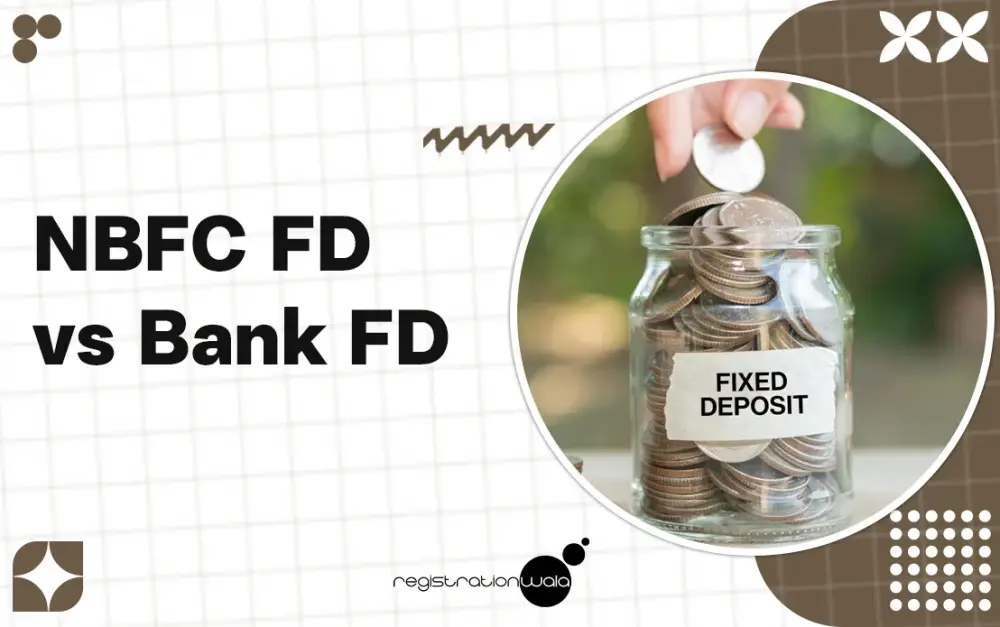NBFC FD vs Bank FD
- June 22, 2024
- Registrationwala

- Home
- /
- Knowledge Base
- /
- News & other businesses
- /
- Blog
- /
- NBFC FD vs Bank FD
NBFC FD vs Bank FD
Fixed Deposits are one of the most popular investment options in India. Before an individual invests their money in FD, it is crucial to know about FD rates offered by various NBFCs and banks in India.
Can’t choose between NBFC FD vs Bank FD? Then this article’s for you.
What is NBFC FD?
According to Companies Act, 2013, NBFCs principally deal in lending, leasing, hire-purchase insurance, investments through shares, stocks, bonds or debentures, and/or chit funds by receiving deposits under a scheme or arrangement in installments or lump sum. These exclude any companies which are involved in activities related to agriculture, trading, and construction, industrial and development activities.
For a company to be considered as an NBFC, NBFC registration or NBFC license is a mandatory requirement. Fixed Deposits which are opened in NBFCs are known as NBFC FDs or NBFC Fixed Deposits.
What is Bank FD?
FDs opened in Banks are known as Bank FDs. Most people prefer to open FDs at banks as they are considered to be the most secure place to open an FD account. In case your bank shuts its operations entirely, it will provide you a security deposit amount as compensation.
However, compared to NBFC FDs, Bank FDs may not provide high interest rates, especially in case of nationalized banks. But this isn’t always the case. Some cooperative banks provide good interest rates, especially to individuals who are senior citizens.
It is important to note that the process of premature withdrawal of a bank FD can be a bit complicated and a penalty charge is also deducted for premature withdrawal which affects interest rate in the overall investment.
Must Read: SEBI Guidelines for Merchant Banking
What should you choose between NBFC FD vs Bank FD?
Selecting the right financier is really important when looking to make your savings grow with a fixed deposit. To help you decide between NBFC FD vs Bank FD, let’s take a look at the following parameters.
Rate of Interest Offered
NBFCs, in general, offer higher interest rates than banks do on FDs. This is because of the credit risk linked with the NBFCs. Bank FD interest rates are generally lower compared to NBFC FD interest rates.
Risk Factor
Bank FDs are considered as safer FDs, especially due to an enhanced insurance cover of Rs. 5 lakhs as announced in 2020’s budget announcement. No such cover is offered by NBFCs. Although credit rating agencies such as CRISIL and ICRA award safety ratings to various NBFCs on the basis of their credentials and reputation.
The safest deposits are those NBFC FDs that have ratings of AAA from ICRA and CRISIL. Selecting the best NBFCs with a strong reputation and high safety ratings should be your priority to avoid instances of losing your interest payments or principal.
Tax Advantages
The tax advantages of bank FDs outweigh the higher interest rate offered by NBFC FDs. You are eligible for receiving a tax deduction of up to Rs. 1.5 lakh per year on your five-year bank deposits under Income Tax Act’s Section 80C. You won't receive any tax benefits, though, if you take any early withdrawals during the lock-in period.
Convenience
When you choose between NBFC FD vs Bank FD, you must consider the convenience of saving and any additional features that you can gain. Online depositing experience, offered by several NBFCs, can allow you to grow your savings easily with the help of a website or app which is easy to use. You can get a loan against your FD or benefit from renewal rate which can help you grow your savings further.
NBFC FD Interest Rates 2024
Here is a list of NBFC FD Interest Rates in 2024:
|
Company Name |
Credit Rating |
Interest Rates (% p.a.) |
Additional interest rate for senior citizens (% p.a.) |
||
|
1-year tenure |
3-year tenure |
5-year tenure |
|||
|
Manipal Housing Finance Syndicate Ltd |
ACUITE – ACUITE A |
8.25 |
8.25 |
7.75 |
0.25 |
|
Shriram Finance |
ICRA-AA+/Stable IND AA+/Stable by India Ratings & Research |
7.59 |
8.38 |
8.47 |
0.50 |
|
Kerala Transport Development Finance Corporation Ltd. |
Guaranteed by Kerala Govt. |
7.00 |
7.00 |
6.75 |
0.25 |
|
PNB Housing Finance Ltd. |
CRISIL-AA/Positive CARE-AA/Positive |
7.45 |
7.85 |
7.65 |
0.30 |
|
Sundaram Home Finance |
CRISIL-AAA/Stable ICRA-AAA/Stable |
7.45 |
7.75 |
7.90 |
0.35 – 0.50 |
|
Sundaram Finance |
CRISIL-AAA/Stable ICRA-AAA/Stable |
7.45 |
7.75 |
– |
0.50 |
|
Muthoot Capital Services Limited |
CRISIL-A+/Stable |
7.21 |
8.07 |
8.38 |
0.25 |
|
ICICI Home Finance |
CRISIL-AAA/Stable ICRA-AAA/Stable CARE-AAA/Stable |
7.25 |
7.65 |
7.60 |
0.25 |
|
Bajaj Finance Limited |
CRISIL-AAA/Stable ICRA-AAA/Stable |
7.40 |
8.05 |
8.05 |
0.25 |
|
LIC Housing Finance Ltd. |
CRISIL-AAA/Stable |
7.25 |
7.75 |
7.75 |
0.25 |
|
Mahindra Finance |
CRISIL-AAA/Stable IND AAA/Stable by India Ratings |
7.60 |
8.05 |
8.05 |
0.25 |
Source: Paisa Bazaar
Conclusion
You must consider your goals when you plan your savings. Whether you go for NBFC FD vs Bank FD, the choice is yours but make sure you do proper market research and choose a plan that suits your requirements, financial goals and risk tolerance. If you want NBFC FD, make sure the NBFC has a valid NBFC certificate and has a good reputation in the market. Bank FDs are safer but the interest rates are lower compared to NBFC FDs.
- 967 views
